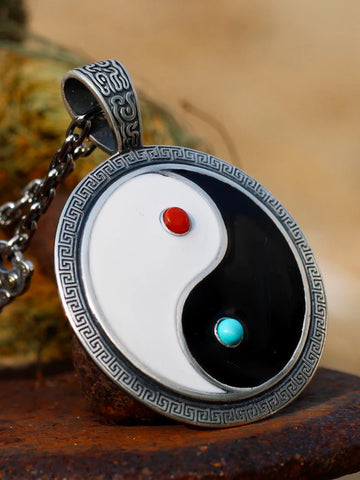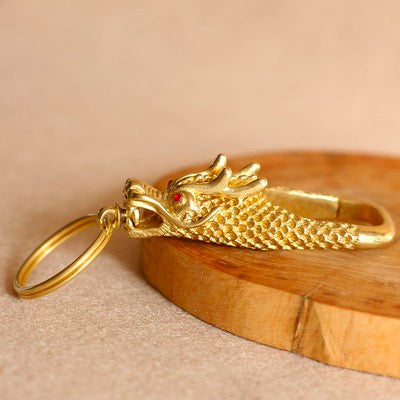Tai Chi jewelry is an exquisite accessory rich in cultural significance and historical heritage. Inspired by the Tai Chi symbol, it combines traditional craftsmanship with modern aesthetics. It not only features unique designs and profound symbolism but also serves as a vital carrier of traditional Chinese culture.
Definition of Tai Chi Jewelry
Tai Chi jewelry is a type of exquisite accessory infused with cultural significance and historical legacy. It draws inspiration from the Tai Chi totem, fusing traditional craftsmanship with contemporary aesthetics. Beyond its unique forms and profound meanings, it stands as a crucial vessel for conveying traditional Chinese culture.
Tai Chi jewelry designs often incorporate the Tai Chi pattern, typically featuring the interplay of the yin and yang fish, alternating black and white elements, and dynamic patterns. In Tai Chi culture, yin and yang symbolize philosophical concepts of opposition, unity, cycles, and transformation. The Tai Chi totem expresses notions of balance, harmony, and nature. Consequently, Tai Chi jewelry embodies desires for balance, harmony, inclusivity, and other positive aspirations, presenting itself as an exquisite accessory that conveys cultural significance.

Tai Chi jewelry encompasses various types, including pendants, rings, earrings, and more, catering to diverse aesthetic preferences and individual needs. Crafting such jewelry demands intricate craftsmanship and rigorous production processes. Initially, precious metals like gold and silver are selected as materials to ensure stability and lasting value. Designers then draw inspiration from the Tai Chi totem, using minimalist lines to depict the forms of yin and yang. Techniques like engraving and hollowing are employed to illustrate the texture of Tai Chi. Finally, high-temperature firing enhances the jewelry's durability and brilliance.
Production Regions of Tai Chi Jewelry
Tai Chi jewelry originates mainly in central China, particularly in regions such as Henan, Shaanxi, and Shanxi. Among these, Luoyang in Henan is one of the birthplaces of Tai Chi jewelry. With its extensive history of Tai Chi culture, Luoyang offers rich cultural foundations for crafting such jewelry.
Luoyang, located in the central plains of China, serves as a cradle of Chinese civilization and holds deep-seated Tai Chi cultural roots. The city's skilled artisans have developed an elaborate tradition of Tai Chi jewelry making, featuring distinctive local characteristics. Numerous jewelry manufacturers in Luoyang operate Tai Chi jewelry production lines, producing a variety of unique and exquisitely crafted pieces that are adored by consumers both domestically and internationally.
Additionally, Xi'an in Shaanxi and Taiyuan in Shanxi are also significant production centers for Tai Chi jewelry. These regions boast rich Tai Chi cultural heritage and craftsmanship. Local artisans proficient in traditional craftsmanship contribute to the creation of Tai Chi jewelry. These areas exhibit diverse jewelry production techniques and styles, contributing to the multifaceted development of Tai Chi jewelry.
Manufacturing Process of Tai Chi Jewelry
The crafting of Tai Chi jewelry involves a refined traditional craft, encompassing steps such as material selection, design, engraving, hollowing, and high-temperature firing. Below is a detailed overview of the manufacturing process of Tai Chi jewelry:
Material Selection: The primary step in Tai Chi jewelry production is material selection, often involving precious metals like gold, silver, copper, and platinum. Precious metals possess stable chemical and physical properties, resisting oxidation and discoloration, ensuring their enduring value.
Design: After material selection, designers proceed to the design phase. This entails considering the jewelry's shape, size, color coordination, and other elements to satisfy consumers' aesthetic preferences. Drawing inspiration from the Tai Chi totem, designers employ minimalist lines to outline the forms of yin and yang, capturing the unique charm of Tai Chi.
Engraving: Engraving is a pivotal craft in Tai Chi jewelry production. Skilled craftsmen use specialized carving tools to engrave Tai Chi patterns onto the metal surface, creating intricate textures and patterns. Engraving demands expertise and patience to achieve impeccable Tai Chi patterns.
Hollowing: Hollowing is another essential technique employed in Tai Chi jewelry crafting. This technique involves removing material from the interior of the metal to reveal the yin and yang patterns on the metal's surface. This craft necessitates exceptional skill and precision to create clear, three-dimensional yin and yang patterns.
High-Temperature Firing: After engraving and hollowing, Tai Chi jewelry undergoes high-temperature firing. This step enhances the jewelry's durability and luster. High-temperature firing requires precise temperature control within specialized furnaces to ensure the quality and appearance of the jewelry.
Characteristics of Tai Chi Jewelry
Tai Chi jewelry, as a vital component of traditional Chinese culture, possesses unique artistic and cultural value. Here are several key characteristics of Tai Chi jewelry:
Inspired by Tai Chi Totem: Tai Chi jewelry draws inspiration from the Tai Chi totem, employing elements of yin and yang, black and white, and dynamic patterns to convey ideas of harmony and balance. This design philosophy encapsulates both traditional Chinese culture and designers' creativity and aesthetics.
Distinctive Forms, Exquisite Craftsmanship: Tai Chi jewelry's distinct forms often feature yin and yang fish, alternating black and white elements, and dynamic patterns. Its crafting involves skilled techniques, with precious metals serving as materials. Engraving, hollowing, and other techniques bring out the texture of Tai Chi, reflecting a rich history and local uniqueness.
Profound Significance, Cultural Depth: Tai Chi jewelry carries profound significance, symbolizing aspirations for balance, harmony, and inclusivity. It serves as both a vessel for conveying beauty and a treasure for preserving millenniums of culture, embodying abundant cultural depth and historical continuity.
Versatility, Suitable for Diverse Audiences: Tai Chi jewelry suits various occasions and demographics. It can be worn as necklaces, earrings, rings, and other accessories, whether in formal settings or daily life, expressing unique taste and demeanor.
Historical and Cultural Context of Tai Chi Jewelry
Tai Chi jewelry, a prominent facet of traditional Chinese culture, holds deep historical and cultural roots. Here's an in-depth exploration of the historical and cultural context of Tai Chi jewelry:
Tai Chi Culture: Rooted in Chinese Daoist philosophy, Tai Chi culture is a pivotal aspect of traditional Chinese culture. The Tai Chi totem comprises elements such as yin and yang, black and white, and dynamic patterns, embodying ideas of harmony, balance, and natural order. This ideology forms both a cosmological outlook and a methodological approach within Chinese philosophy.
Historical Legacy: The history of Tai Chi jewelry can be traced back to ancient times, with early appearances in the Han Dynasty. During the Ming and Qing Dynasties, Tai Chi jewelry gained popularity and developed its distinctive design style and craftsmanship. In the modern era, Tai Chi jewelry preserves its traditional elements while integrating modern design concepts and material techniques, evolving into a new art form.
Cultural Significance: Tai Chi jewelry, drawing inspiration from the Tai Chi totem, symbolizes balance, harmony, and inclusivity through the use of yin and yang, black and white, and dynamic elements. Beyond being an aesthetic medium, it embodies and preserves cultural treasures, carrying profound cultural significance and historical heritage.
Social Significance: As a part of traditional Chinese culture, Tai Chi jewelry not only holds artistic value but also carries profound social significance. It represents the wisdom and creativity of the Chinese people and conveys the cultural spirit and values of the Chinese nation. Moreover, the production and sale of Tai Chi jewelry contribute to local economic development and employment opportunities.
Contemporary Applications of Tai Chi Jewelry
Tai Chi jewelry, as a pillar of traditional Chinese culture in contemporary society, has found widespread applications. Here are several key applications of Tai Chi jewelry in modern times:
Fashion Accessories: Tai Chi jewelry has become a favored fashion accessory, admired for its unique designs and exquisite craftsmanship. Its distinct forms and skillful craftsmanship add elegance and confidence to those who wear it. Particularly among young individuals, wearing Tai Chi jewelry showcases personal uniqueness and taste.
Cultural Preservation: As an integral part of Chinese culture, Tai Chi jewelry possesses profound cultural connotations and historical legacy. Wearing Tai Chi jewelry signifies the continuation and promotion of traditional Chinese culture, displaying cultural sophistication and aesthetic discernment.
Gift Giving: Tai Chi jewelry, an exquisite accessory, has become a popular choice for gift-giving. Whether in business settings, social gatherings, or exchanges among friends and family, wearing Tai Chi jewelry expresses respect, gratitude, and cultural refinement.
Health and Decoration: Some individuals view Tai Chi jewelry as a decorative item with potential health benefits. Some believe that wearing Tai Chi jewelry can help regulate the balance of yin and yang within the body, promoting physical well-being. Additionally, Tai Chi jewelry's form and craftsmanship render it a collectible art piece, attracting the interest of many collectors.
Symbolism of Tai Chi Jewelry
Tai Chi jewelry, an integral part of Chinese traditional culture, carries profound symbolic meaning. Here are some key symbols associated with Tai Chi jewelry:
Harmony of Yin and Yang: The Tai Chi jewelry's patterns are composed of yin and yang, black and white, and dynamic elements, expressing the concept of harmonizing opposites and achieving balance and harmony. This concept is a fundamental cosmological and philosophical principle in Chinese culture, embodying the pursuit of equilibrium, harmony, and stability.
Growth and Transformation: The contrasting black and white elements in Tai Chi jewelry also symbolize the stages of growth in all things. Black signifies yin energy, while white signifies yang energy. The interaction between these two energies fosters growth and transformation. Wearing Tai Chi jewelry can symbolize the pursuit of life's growth and changes.

Vitality of Life: The dynamic elements in Tai Chi jewelry symbolize the vitality of life. The yin and yang fish in the Tai Chi totem, through dynamic interaction, give rise to the continuation of life. Wearing Tai Chi jewelry can signify the pursuit of life's vitality and the maintenance of a positive mindset.
Cultural Heritage: As a part of Chinese traditional culture, Tai Chi jewelry carries deep cultural connotations and historical legacy. Wearing Tai Chi jewelry can symbolize the continuation and promotion of Chinese traditional culture, showcasing cultural refinement and aesthetic discernment.
Materials of Tai Chi Jewelry
Tai Chi jewelry is crafted from a variety of materials, each bestowing unique characteristics and styles. Here are several common materials used in Tai Chi jewelry:
Metal Materials: Metal materials are among the most commonly used for Tai Chi jewelry, including gold, silver, copper, and platinum. These metals contribute to various styles of Tai Chi jewelry through different metal properties and colors. Gold and silver are particularly prevalent, with gold exuding opulence and grandeur, while silver imparts a fresh and elegant charm.
Gemstone Materials: Gemstone materials result in exquisite but often expensive Tai Chi jewelry due to their splendid and precious nature. Examples include crystal, turquoise, jade, and garnet. Gemstones add a touch of luxury and texture to Tai Chi jewelry, enhancing its visual appeal.
Wooden Materials: Tai Chi jewelry crafted from wood possesses a unique character. Woods like rosewood, sandalwood, and mahogany are common choices. Wooden Tai Chi jewelry often features an antique and elegant style, evoking a natural charm.
Glass Material: Glass, an ancient material, is used to create vibrant, translucent Tai Chi jewelry. Its distinctive craftsmanship and artistic style rejuvenate the art form. Glass Tai Chi jewelry incorporates modern elements, displaying a unique artistic allure.
Pearl Material: Pearl material imparts a gentle and elegant touch to Tai Chi jewelry. Varieties include freshwater pearls and saltwater pearls. Pearls' soft luster and rounded texture complement the traditional cultural significance of Tai Chi jewelry.
In conclusion, Tai Chi jewelry represents an indispensable component of traditional Chinese culture, holding both irreplaceable artistic and humanistic values. Serving as a vessel for conveying beauty and a treasure of cultural heritage, Tai Chi jewelry enriches contemporary life with its applications and developments.



















